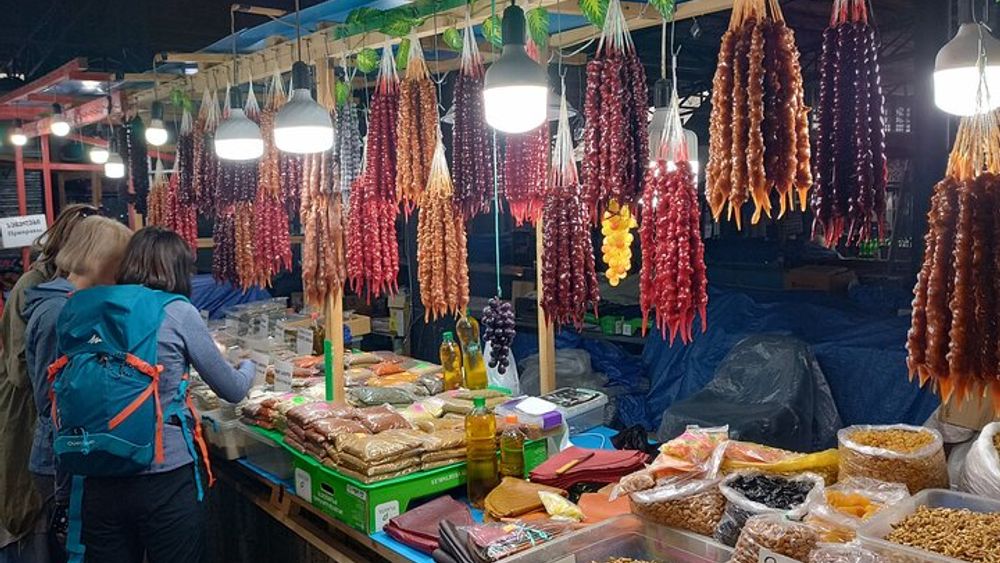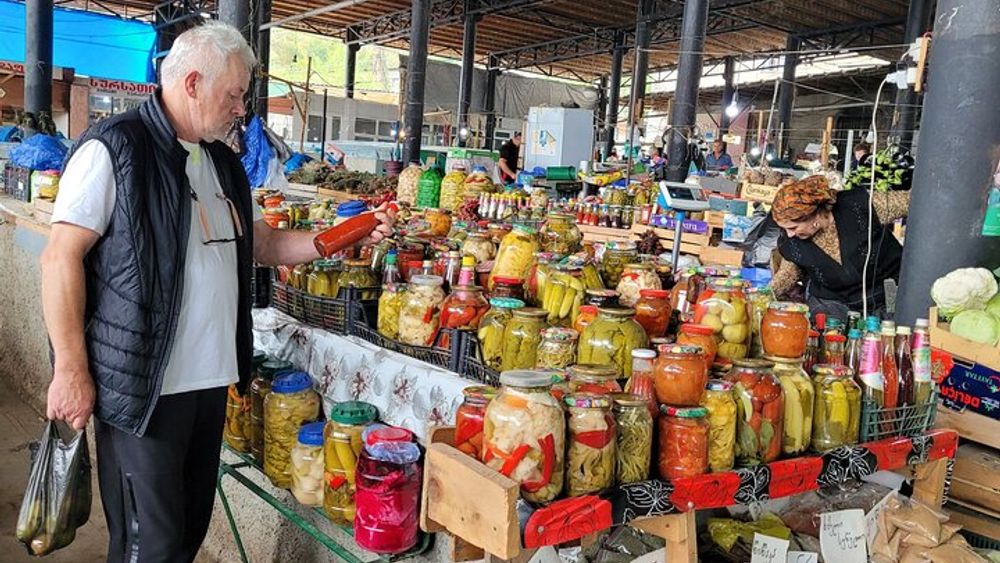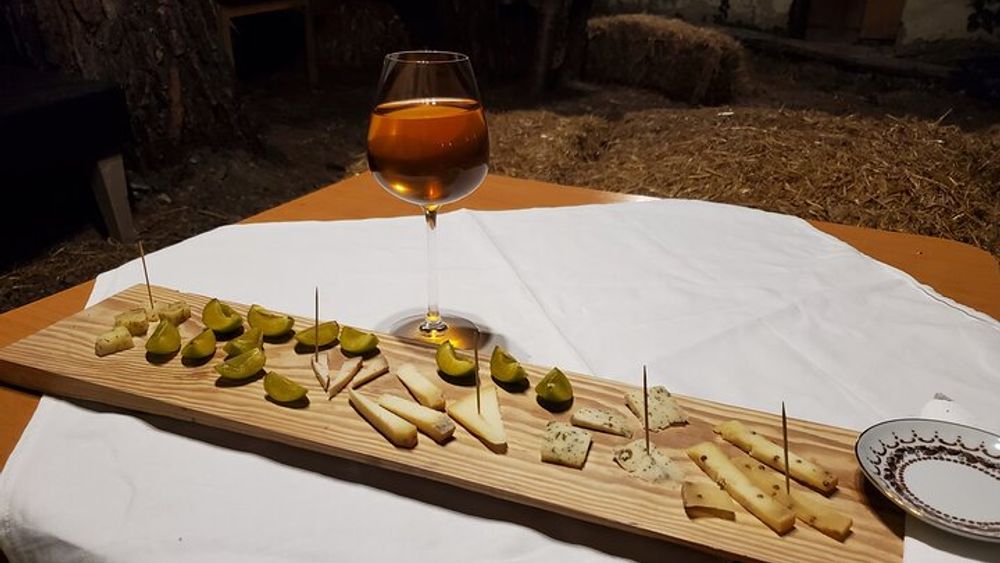Private Ultimate Foodie Kakheti Experience with wine and cheese
10 hours
From 09:00
Group 1+
Russian, German, French
10 hours
09:00
What you'll do
Discover the ultimate foodie experience on a private tour from Tbilisi to the Kakheti region! In Telavi, we'll explore Batonis Tsikhe, a 17th-century fortress with stunning views of the area. Then, we'll venture to the Telavi Farmers' Bazaar, where you can sample delicious street food, fresh produce, meat, and cheeses. We'll try seasonal fruits and indulge in pickled jonjoli, goat cheese, sulguni cheese, churchkhela, and other Georgian delicacies. Next, we'll visit a cheese factory where we'll see over ten different varieties of cheese being made and sample some of their most delectable creations. Finally, we'll visit a private winery where we'll meet winemakers and taste some of the best wines in Georgia, including the traditional Rkatsiteli amber wine. Indulge in the rich flavours of Georgian cuisine and make memories that will last a lifetime. Come join us for a foodie adventure in Telavi and the Kakheti region!
Itinerary
- 1Turaida Castle is one of the most famous, most popular and most visited castles in Latvia. Not only because Turaida is located on the classic tourist route, and to visit Latvia without stopping by in Sigulda and neighbouring Turaida is even somehow indecent. But also because the Turaida castle was restored and restored in the form in which we now see the usual medieval castle.
- 2The castle was built in 1214 by order of the Riga Archbishop Albert.
- 3In the 13th century, the Turaida castle and its environs bore the German name Friedland, but the Libyan name Turaida somehow took root and quietly replaced the German one. In Libyan, the word Turaida means the Garden of God, from Torah - God and Aida - the garden.
- 4
After visiting the castle ruins, you can stroll along the ancient stone walls, climb the towers and go to events on the open-air stage.
The Swordsmen who controlled the left bank of the Gauja River built the Sigulda Castle from 1204 to 1209. Originally it was a castellum fortress with a chapel. Later, the castle was rebuilt in the construction of the convent type. The castle had a wide outer forburg, and a lively settlement of merchants and artisans formed near it.
During the Livonian War, Russian, Polish and Swedish troops fought near the castle. The castle was damaged in wars and over time lost its military significance. In addition, at the beginning of the 18th century during the Northern War, the castle was destroyed, after which it was no longer restored.
After visiting the ruins, you can walk along the stone walls and climb the castle towers.
The majestic walls of the castle ruins, built of boulder, contain many historical events and legends. It is very exciting to imagine how the knights of the Livonian Order once honed their fighting skills here.
In the ruins of the castle, there is an open-air stage where visitors can annually enjoy unforgettable moments of the Opera Festival and other events.
The territory of the Sigulda Castle of the Livonian Order is a suitable place to appreciate the beautiful landscapes of the Gauja Valley.
- 5
The new Sigulda castle was built in 1881 by order of Prince Kropotkin. After the First World War, the palace became the property of the Society of the Latvian Press, and the restructuring carried out affected all buildings and interiors. After the Second World War, the sanatorium of the USSR Ministry of Health was located in the castle.
Today, the Sigulda City Council conducts economic activities in the palace. The tower of the Sigulda Palace offers a picturesque view of the surroundings.
- 6
Gutman Cave is the largest cave in Latvia and the whole Baltic. Located on the right bank of the Gauja River in the Gauja National Park, near the city of Sigulda. The walls of the cave are composed of red sandstone, formed in the Devonian period (about 410 million years ago). A creek flows into the Gauja River from the cave.
The depth of the cave is 18.8 meters, the maximum width is 12 meters, and the height is 10 meters. The area of the cave is 170 square meters, the volume is 500 cubic meters.
What's Included
Private transportation
Bottled water
Wine tasting
Cheese tasting
Notes
Not stroller accessible
Not suitable for pets
No public transportation nearby
Infants must not sit on laps
Infant seats unavailable
Not wheelchair accessible
Not recommended for pregnant travelers
Please note that this tour includes tastings of Georgian wine and other alcoholic beverages. Participants must be of legal drinking age and are responsible for their own consumption. It is important to drink responsibly and to be aware of your limits.
Please also note that we cannot provide options for individuals with gluten or lactose intolerance, and there are no Halal options available. If you have dietary restrictions, please consider this before booking the tour. Our goal is to provide an enjoyable and safe experience for all participants, and we appreciate your understanding in this matter.
Our guide will be waiting for you in front of the hotel or outside the apartment building at the designated start time of the tour.
Gallery



Cancellation policy
A full refund will apply if you cancel more than 24 hours before the activity start time.
No refund is possible if you cancel less than 24 hours before the activity start time.
Get inspired by a world of food
Carefully curated guides, reviews and inspiration by our team of food travellers and critics.




